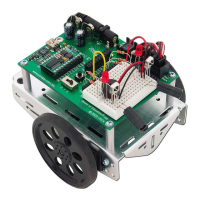Chapter 4: Infrared Object Detection · Page 35
Chapter 4: Infrared Object Detection
Today's hottest products seem to have one thing in common: wireless communication.
Personal organizers beam data into desktop computers, and wireless remotes let us
channel surf. With a few inexpensive and widely available parts, the BASIC Stamp can
also use an infrared LED and detector to detect objects to the front and side of your
SumoBot.
Detecting obstacles doesn’t require anything as
sophisticated as machine vision. A much simpler
system will suffice. Some robots use RADAR or
SONAR (sometimes called SODAR when used in air
instead of water). An even simpler system is to use
infrared light to illuminate the robot’s path and
determine when the light reflects off an object. Thanks
to the proliferation of infrared (IR) remote controls, IR
illuminators and detectors are easily available and
inexpensive.
INFRARED HEADLIGHTS
The infrared object detection system we’ll build on the
SumoBot is like a car’s headlights in several respects.
When the light from a car’s headlights reflects off
obstacles, your eyes detect the obstacles and your
brain processes them and makes your body guide the
car accordingly. The SumoBot uses infrared LEDs for
headlights. They emit infrared, and in some cases, the
infrared reflects off objects, and bounces back in the
direction of the SumoBot. The eyes of the SumoBot
are the infrared detectors. The infrared detectors send
signals to the BASIC Stamp indicating whether or not
they detect infrared reflected off an object. The brain
of the SumoBot, the BASIC Stamp, makes decisions
and operates the servo motors based on this input.
What is Infrared?
Infra means below, so Infrared is
light (or electromagnetic radiation)
that has lower frequency, or longer
wavelength than red light. Our IR
LED and detector work at 980 nm
(Nanometers) which is considered
near infrared. Night-vision
goggles and IR temperature
sensing use far infrared
wavelengths of 2000-10,000 nm,
depending on the application.
Approximate
Color
Wavelength
Violet 400 nm
Blue 470
Green 565
Yellow 590
Orange 630
Red 780
Near infrared 800-1000
Infrared 1000-2000
Far infrared 2000-10,000 nm

